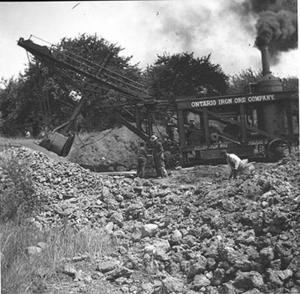Iron Ore
Iron ore was first discovered in Ontario by a mr. Knickerbocker in 1811 when he went to  dig a well to water his cattle. Later in the year 1816 a crude forge was set up by Samuel Smith to process the ore into bar iron at a rate of about 400 pounds per day. Then in 1825 a furnace was built by Henry S. Gilbert which increased production to three to four tons of pig iron a day. Later in the 1840's other furnaces were built and production increased yet again.
dig a well to water his cattle. Later in the year 1816 a crude forge was set up by Samuel Smith to process the ore into bar iron at a rate of about 400 pounds per day. Then in 1825 a furnace was built by Henry S. Gilbert which increased production to three to four tons of pig iron a day. Later in the 1840's other furnaces were built and production increased yet again.
In the beginning all this ore was dug by hand with picks and shovels. The ore was close to the surface and after they had extracted the red rock from the layers of limestone they would fill in the void with earth to keep the area farmable. Where the ore went deeper they would have to run wheel barrows up steep planks and mound dirt and stone along the sides to gain access.
The ore was broken down using drills and powder then carted away to nearby ports along lake ontario such as bear creek. The roads between the ore mines and the lake became red from the dust of the ore and it was said that a person knew someone was from Ontario by the red dust that clung to their boots and shoes.
As word of Ontario's ore deposits spread, outsiders began to take interest. In 1870 the Ontario Iron Co. was formed and the owners built a modern anthracite blast furnace on the original Furnaceville furnace site. Then a railroad company came and tracks were built. During this time 25 men ran the furnace and  between 50 and 250 men were employed in the mine pits. The capacity of the Ontario Iron company's furnace was now at 100 tons per week.
between 50 and 250 men were employed in the mine pits. The capacity of the Ontario Iron company's furnace was now at 100 tons per week.
In the late 1880's more abundant iron ore mines were opened in Minnesota. The major mining outfits closed up until the early 1900's when it was discovered that iron ore could be used as red pigment in paint for structural iron and barns. A paint mill was built in Ontario, where the iron ore was ground for color and shipped around the world to be mixed with linseed oil and used as paint.
Iron is the most common metal on earth. It is different from other metals like gold, copper and bronze because it can be made very hard, is magnetic, and rusts into a beautiful red color.
Today you'll find a beautiful park with playgrounds, a community center and a oddly shaped long lake running east to west used for fishing, swimming and paddle boating. As you walk the north trail to the cache you can spot the signs of the mining operation from over a hundred years ago and even some of the iron ore itself.
The cache itself is a large wooden box that shouldn't be too difficult to find, just re-hide it well so that it doesn't get muggled. The challenge will be in finding the combination that opens the lock so you can sign the logbook and claim this as found.
Please don't use any tools to open this cache. It won't be necessary. Everything you need to find the combination is there on the box. Take your time, study the box and you will be successful.
This cache is a field puzzle and once found, you must figure out how to open the box to sign the logbook. Only once the logbook is signed may you claim this as " found".